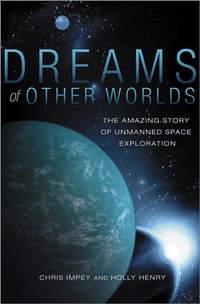Review: Dreams of Other Worldsby Jeff Foust
|
| In the chapter on Viking, the authors link that mission to the development of the “Gaia hypothesis” of the Earth’s biosphere: James Lovelock, the scientist who first developed the Gaia concept, was developing experiments like those eventually flown on Viking to search for life. |
The key word, arguably, of the book’s subtitle is “story”: this book is not intended to be a comprehensive history of robotic space exploration, but instead a look at some of the key missions, in the authors’ opinion, and their relevance. They devote a chapter each to eleven missions: Viking, the Mars Exploration Rovers, Voyager, Cassini, Stardust, the Solar and Heliospheric Observatory (SOHO), Hipparcos, Spitzer, Chandra, Hubble, and the Wilkinson Microwave Anisotropy Probe (WMAP). Any such selection of missions, as the authors have done, is bound to raise some questions, including the dominance of NASA missions (Hipparcos is the only mission not led by NASA, although ESA is a major partner in several, including Cassini, Hubble, and SOHO.) No Venus missions, from Soviet-era Veneras to NASA’s Magellan, make the cut, nor do any of the dozens lunar missions. And, arguably, NASA’s Cosmic Background Explorer (COBE) is a more significant mission than WMAP, netting a Nobel Prize for the mission’s key scientists, although it is mentioned in the chapter on WMAP.
That said, the authors offer an interesting look at the missions they have selected for this book. They eschew a basic, straightforward look at the histories of these missions and their scientific achievements, instead choosing to take a broader look at the historical, scientific, and even cultural significance of these missions. The actual development and operations of these missions are thus often a modest part of each chapter.
This approach can offer some interesting insights. In the chapter on Viking, for example, the authors link that mission to the development of the “Gaia hypothesis” of the Earth’s biosphere: James Lovelock, the scientist who first developed the Gaia concept, was developing experiments like those eventually flown on Viking to search for life there when he became curious about the effect life had on the Earth. The authors spend as much time in the chapter exploring this link, and “Earth system science,” as they do the Viking mission to Mars and its scientific accomplishments themselves. Other times, sections of the book can seem like little more than intellectual tangents, such as the discussion of the evolution of life on Earth and its ability to sense light in the chapter on the Spitzer infrared observatory, and an aside on the rise of electronic and other “space music” in the chapter on WMAP.
For those already familiar with the exploits of robotic spacecraft studying our universe, Dreams of Other Worlds doesn’t add much in the way of new information about those missions themselves. However, besides being a good introduction to those missions for people less familiar with them, the book helps provide a bigger picture of the significance of studying the universe with these robotic explorers, be they spacecraft that remain in Earth orbit or, like Voyager 1, head out into the cosmos.
